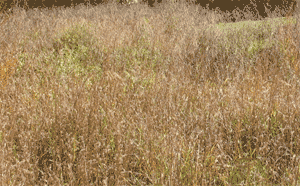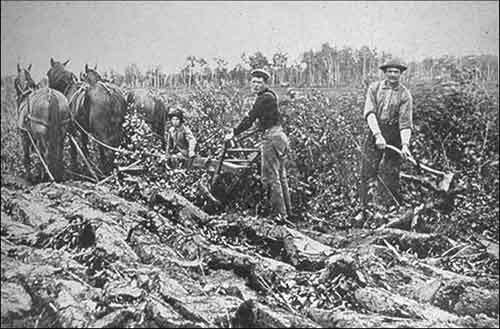Grasslands are a vital but diminishing natural resource throughout the northeastern United States. Numerous wildlife species, particularly birds, are dependent on these areas for food, cover or breeding. Animals that can be found in grasslands include bobolink, eastern meadowlark, black racer, horned lark, northern leopard frog, small rodents, turkey, wood turtle and numerous insects. This website provides information on grasslands in Connecticut and a map of where the larger grasslands can be found.
Definition of a Grassland
Grasslands are defined as areas in which grasses contribute more than 50% of the herbaceous cover. Most grasses are in the plant family Poaceae and are adapted to hot, dry climates. They have linear, narrow leaves and extensive root systems. The other species that may be present in grasslands are plants called forbs: broadleaved, herbaceous plants such as milkweeds, asters and goldenrods. Few, if any, trees and shrubs occur.

History of Grasslands
Prior to European settlement, Connecticut was largely forested with grasslands found naturally in areas with dry, sandy deposits, tidally flooded areas, areas along rivers and streams with excessive erosion and sedimentation, and in wetlands too wet to support woody plant growth. In addition, some grasslands were created and maintained by Native Americans and fire. European settlement brought the clearing of most of the forests for agriculture and later, charcoal production, such that by the 1800’s grasslands maintained by plowing and grazing were widespread throughout the state.
Land clearing by settlers

Photo courtesy Paterson GlobalFoods Inc.
- Since the end of the 1800’s, grasslands have diminished in quality and quantity due to changes in agricultural practices, migration of farmers westward, and an increase in human population. Many grasslands have been lost to development or without management, have grown back into forests. With this loss, wildlife dependent on these grasslands has been negatively impacted.
- Researchers have documented declines in grasslands bird populations throughout the northeast over the past 3 to 4 decades as well as noting that currently, many state listed rare bird species are associated with grasslands.
Birds of Warm and Cool Season Grasslands
Grassland bird species habitat use varies depending on both the type of grassland (warm or cool) and also the size of the grassland. Many of these birds have minimum habitat size requirements for nesting, and have plant species or structure preferences. Some will nest only in grasses of a particular height; others prefer a mix of tall and short vegetation, or a particular grass species or a mix of grass and forbs.
Warm season grassland bird species include upland sandpipers, grasshopper sparrows, and vesper sparrows. (All these species are included in Connecticut's list of Endangered, Threatened and Special Concern Species.) The CT DEP has fact sheets on the following bird species:
Cool season grassland bird species include savannah sparrows, eastern meadowlarks, and bobolinks. (All three species are state listed rare species). These birds require smaller grasslands for nesting – usually less than 25 acres. They are generalists in comparison to warm season grassland birds, nesting, foraging and raising young in a variety of habitats includes hayfields, meadows and pastures. These birds will sometimes also use warm season grasslands for nesting.
Management of Grasslands
- Establishing, managing and maintaining grasslands depend on a number of factors. While establishment of a warm versus cool season grassland will differ, many of the same principles apply to their maintenance including, mowing dates, prescribed burning, grazing and herbicide use.
- Most of Connecticut’s grasslands would revert to forest without active management.
- Mowing in the fall every several years is an important technique to control the growth of trees and shrubs.
- Mowing of fields is an important management technique, but the timing of mowing is critical for nesting birds. Mowing of fields should take place outside of the nesting season (April 15 to August 15). Management of active agricultural fields can be more challenging, but there are both management techniques such as raising the mowing bar in areas of bird concentrations, as well as state and federal cost share programs to accommodate modified mowing techniques.
More Information on Grassland Establishment and Management
Proper Timing to Mow Native Plant Meadows Can Protect Pollinator Habitat. By Dr. Kimberly A. Stoner, Department of Entomoloy, The Connecticut Agriculture Experiement Station.
Rothbart, Paul and Steve Capel. 2006. Maintaining and Restoring Grasslands (Chapter 3) in Managing Grasslands, Shrublands and Young Forests for Wildlife. J.D. Oehler, D.R. Covell, S.Capel, B. Long (editors). Published by the Northeast Upland Habitat Technical Committee, Massachusetts Division of Fisheries & Wildlife. (p.14 – 27)
Chapter 3 (pertaining specifically to grasslands) is available online at: Maintaining and restoring grasslands Hard copies of the entire book are available for purchase at the Connecticut DEP Store.
Other website resources:
- New Hampshire Habitat Stewardship Series - Grasslands
- New Jersey Habitat Management for Grassland Birds
- Rhode Island Habitat Descriptions, Threats and Actions (including grasslands)
The creation of this web page and cool season grassland map development was funded in part through a grant from the Connecticut Department of Environmental Protection to the University of Connecticut. The map is not currently available through this website. Please contact the Connecticut DEP for information.
For Citation Purposes: Connecticut Sea Grant & University of Connecticut’s Center for Land Use Education and Research. (June 8, 2016). Grasslands. https://climate.uconn.edu/habitats-resources/grasslands